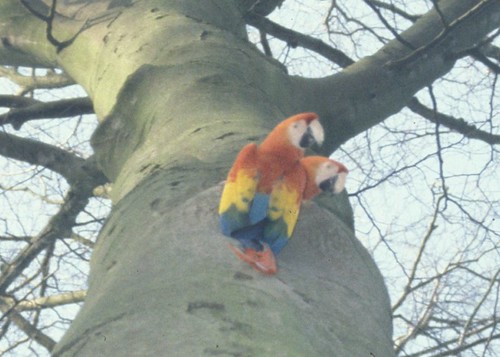 The Dutch Macaw population in 1989We from Araproject always love to hear from the public. We know many people check in at our website to stay informed about the developments of the Scarlet macaws. In our talks with the people we meet, we often get questions about the origin of the macaws. Many locals recall bigger groups of macaws flying in the research area.
The Dutch Macaw population in 1989We from Araproject always love to hear from the public. We know many people check in at our website to stay informed about the developments of the Scarlet macaws. In our talks with the people we meet, we often get questions about the origin of the macaws. Many locals recall bigger groups of macaws flying in the research area.
 Apperently the macaws where nesting in 1989What is unknown is when this big group of around 13 disappeared and what caused their disappearance. Even worse then that, we don't have a clue about the age of Toos and Nape. They could have been born in the 80ties or 90ties, there really is no telling. If they were born in the late 90ties they would now be reaching their top breeding age. If they were born at the start of the 80ties their best years have gone and new offspring is desperately needed to sustain the population of Scarlet macaws.
Apperently the macaws where nesting in 1989What is unknown is when this big group of around 13 disappeared and what caused their disappearance. Even worse then that, we don't have a clue about the age of Toos and Nape. They could have been born in the 80ties or 90ties, there really is no telling. If they were born in the late 90ties they would now be reaching their top breeding age. If they were born at the start of the 80ties their best years have gone and new offspring is desperately needed to sustain the population of Scarlet macaws.
That is why we were so happy to receive some slides of a person now living in Curacao. He lived in the area the macaws frequented during the 80ties and early 90ties and had the great fortune to make pictures of the macaws at that time. The pictures you see above were taken on the 26 or 27 of March 1989. Non of the Scarlet macaws in these pictures is Toos or Nape. Their beak coloration is different and their overall appearance is not reminiscent of either of the present Scarlet Macaws.
These birds are clearly inspecting a nest and might even have been breeding at the time. So maybe these are the parents of Toos and Nape. Who can say.
We hope that this message will inspire anyone who might have old pictures of the Dutch Scarlet macaw population to contact us and sent us those images. The could be immensely valuable in determining the age and family ties of the present Scarlet macaws. Please don't hesitate to contact us!
Thank you!